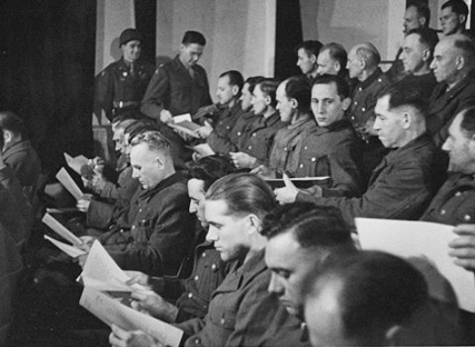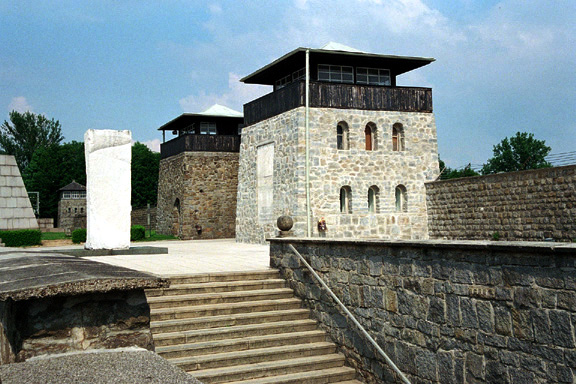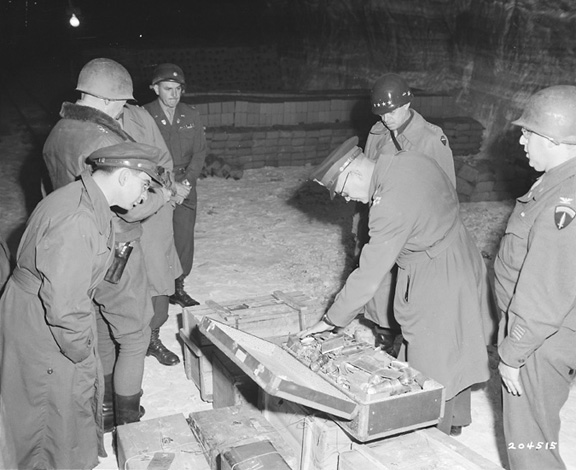Dachau TrialsUS. vs. Hans Altfuldisch, et al On March 7, 1946, charges of participating in a "common design" to violate the Laws and Usages of War under the 1929 Geneva Convention and the Hague Convention of 1907 were brought against a group of 61 men, associated with the infamous Mauthausen concentration camp near Linz, Austria. The charges, which did not include "Crimes Against Humanity," were related to the fact that the prisoners included Soviet Prisoners of War, captured civilian resistance fighters, and Allied nationals including a few Commandos and spies. The American Military Tribunal proceedings in the Mauthausen case were conducted in a courtroom at the former Dachau concentration camp complex, starting on March 29, 1946. The Mauthausen proceedings were officially known as US. vs. Hans Altfuldisch, et al because Altfuldisch was the first name on the alphabetical list of the accused. Although Mauthausen was in the Soviet zone of occupation in Austria, America had jurisdiction over the war criminals in the Mauthausen concentration camp by virtue of being the liberators of the camp on May 5, 1945. The case of the 61 staff members of the Mauthausen concentration camp was the second proceeding of the American Military Tribunal at Dachau; the first one, the trial of 40 staff members of the Dachau concentration camp, ended in the conviction of all of the accused on the charge of participating in a common design to violate the Laws and Usages of War under the Geneva Convention of 1929. The concept of the "common design" criminal charge was the innovative idea of Lt. Col. Murray C. Bernays, a Lithuanian Jew who had emigrated to the United States at the age of 6. The following words, written by Bernays before the end of the war, while the war crimes trials were still in the planning stage, are quoted by Robert E. Conot in his book "Judgment at Nuremberg": The crimes and atrocities were not single or unconnected, but were the inevitable outcome of the basic criminal conspiracy of the Nazi party. This conspiracy, based on the Nazi doctrine of racism and totalitarianism, involved murder, terrorism, and the destruction of peaceful populations in violation of the laws of war. A conspiracy is criminal either because it aims at the accomplishment of lawful ends by unlawful means, or because it aims at the accomplishment of unlawful ends by lawful means. Therefore, such technicalities as the question whether the extermination of fellow Germans by Nazis perpetrated before there was a state of war, would be unimportant, if you recognize as the basic crime the Nazi conspiracy which required for success the killing of dissident liberal Germans and the extermination of German (and non-German) Jews before and after the war had begun. Bernays was of the opinion that the German people should be made to feel a sense of their guilt and a realization of their responsibility for the crimes committed by the Nazis and the SS. The German people should come to understand the barbarism that they had supported and to realize the criminal nature of the Nazi regime. Bernays thought that it was necessary to prove the conspiracy of the Nazi leadership in the war crimes that were committed so that all the Nazi criminals, large and small, would be caught in the same web. By January 1946, when preparations for the Mauthausen trial began, America's foreign policy was beginning to change; an Iron Curtain had descended over the continent of Europe, as Winston Churchill so eloquently characterized the takeover of the victorious Communist Soviet Union, according to the Allied agreement at Yalta. America was just beginning to see the former Nazi Germany as a future ally against Communism, but for now the war crimes trials continued unabated. Lt. Col. William D. Denson was the chief prosecutor in the first four concentration camp cases brought before the American Military Tribunal at Dachau. A German civilian, Baron Karl von Posern, a former Mauthausen prisoner who had been a defense attorney in the first Dachau trial, was recruited for the prosecution team in the Mauthausen case. Three other American lawyers also joined the Mauthausen prosecution team: Lt. Col Albert Barkin, Captain Charles Matthews, and Captain Myron N. Lane. Mauthausen was considered to be the worst of the concentration camps in the Greater German Reich, even worse than Auschwitz. Along with Gusen, which later became one of the Mauthausen sub-camps, it had been designated on January 1, 1941 as one of only two Class III camps in the Nazi concentration camp system. Prisoners sent to Mauthausen were labeled "Return Unwanted." They were mainly condemned criminals, asocials considered to be incapable of rehabilitation, Russian Prisoners of War who were Communist Commissars, and hard-core Communists and anarchists who were regarded as dangerous "enemies of the state." A large number of the prisoners were "Red Spaniards" or "Spanish Republicans," the soldiers who had fought on the side of the Communists in the Spanish Civil War. British SOE agents who aided the French resistance, and American OSS men, who were caught doing sabotage behind enemy lines, were also sent to Mauthausen. The location of the Mauthausen camp, in a scenic spot on a hill above the Danube river, was chosen because it had a stone quarry. Condemned German criminals were put to work to provide the beautiful golden granite that Hitler needed for his building project in nearby Linz, his boyhood home, where he intended to retire some day. The start of World War II in 1939 interrupted his plans and nothing was ever built except a bridge in Linz and the Mauthausen camp itself. The Mauthausen prison is a stone fortress built with granite from the quarry, as shown in the photo below. The site of the camp had previously been a POW camp in World War I. Mauthausen was the most beautiful of all the Nazi concentration camps, and at the same time, the most cruel.  After the Allied victory in World War II, Benjamin B. Ferencz, a Jew born in Translyvania in 1920, who came to America as an infant, was put in charge of gathering evidence of Nazi war crimes in the concentration camps.  In the photo above, taken on April 12, 1945, the soldier on the far left is Benjamin B. Ferencz. In the center is General Eisenhower and behind him, wearing a helmet with four stars is General Omar Bradley. They are inside a salt mine near Ohrdruf, Germany where Nazi gold and art treasures were found and confiscated by the Americans. In 1945, Ferencz was transferred from General Patton's army to the newly created War Crimes Branch of the U.S. Army, where his job was to gather evidence for future trials of German war criminals. Ferencz was with the US Troops when they entered Buchenwald, then Dachau and finally the Mauthausen and Gusen camps, the last to be liberated, just days before the war ended. In his book "Never Again," Gilbert quotes Ferencz as follows: I had entered the concentration camp at Mauthausen/Gusen as a war crimes investigator for the United States army. Piles of corpses littered the area. Starving "Musselmänner," the inmates slang for walking skeletons, stared with vacant eyes at the liberating American troops. An inmate registrar embraced me joyfully. One of his jobs had been to type identification cards for the SS guards; when the guards were reassigned, the card was to be destroyed. The inmate, whose name I shall never know, had at great risk to his life, failed to burn the cards. Instead, he had buried them carefully in a field. After he greeted me he left the barrack and, a few minutes later, returned, unwrapped a soiled box, and handed me a complete record and picture of every SS man who had ever been in the camp! It was invaluable evidence for a war crimes prosecutor. I was moved by the blind faith which inspired the unknown prisoner to risk his life in the conviction that there would come a day of reckoning. With the help of this list, the perpetrators of war crimes in the Mauthausen concentration camp, that were still alive, were hunted down and 61 men were brought before the American Military Tribunal at Dachau in the initial case against the Mauthausen staff members. The proceedings against the 61 Mauthausen accused began on March 29, 1946 and ended on May 13, 1946. The main trial was followed by other subsidiary trials. The list of the accused in the first Mauthausen proceeding is as follows:
SS Dr Friedrich - Karl Entress : Death
Sentence (Executed on 28th May 1947) Heinrich Häger : Death Sentence
(Executed on the 27th May 1947) Ferdinand Lappert : Death Sentence (Commuted
to Life Imprisonment) Thomas Sigmund : Death Sentence (Executed
on 27 May 1947) The Case against August EigruberThe Defense CaseTestimony of Jack TaylorGas Chamber TestimonyConfessions of the AccusedProsecution WitnessesThe testimony of Willy FreyTrial of Spanish KaposFranz Kofler TrialBack to Dachau TrialsBack to Mauthausen indexHomeThis page was last updated on September 9, 2009
|